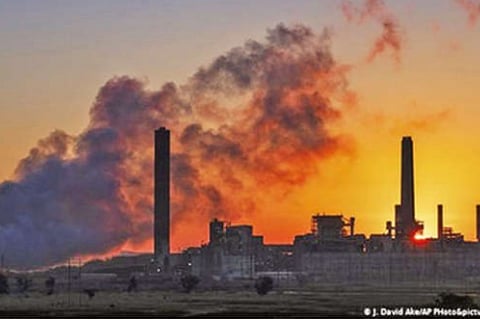

Washington
While greater distances have resulted in colder cycles, shifts closer to the ball of heat have led to warmer, interglacial periods.
In the late 20th century, when scientists started looking at how temperatures have changed over time, they observed a much faster rate of planetary warming from the 1980s than had previously been recorded. In 1998, researchers from the US University of Massachusetts Amherst and the Laboratory of Tree-Ring Research at the University of Arizona published a study showing the average annual global temperature over the past 1,000 years.
To work out earlier temperatures going back half a millennium before the thermometer was invented, they studied so-called proxy or natural records — measurements of ice cores, tree rings and corals. The outcome illustrated little variation for many hundreds of years until the 20th century, when there was suddenly a sharp rise.
In 2013, research published in the journal Science analyzed even earlier temperatures, dating back 11,000 years. The conclusion was the same: our planet has warmed faster in the past century than at any time since the end of the last ice age.
The study also revealed that for the last 2,000 years Earth has actually been in a natural cooling period in terms of its position relative to the sun. But this natural cooling has gone unregistered due to unprecedented warming caused by human emissions of greenhouse gases, the paper explains. What do CO2 emissions have to do with climate change? The greenhouse effect — a natural process that warms the Earth — is necessary to sustain life on the planet. It happens when certain gases in our atmosphere trap the heat emitted from Earth and act as the planet’s very own greenhouse. The natural heat-trapping gases in our atmosphere, which include carbon dioxide (CO2), methane and nitrous oxide, are necessary to keep the Earth’s surface temperature warm.
Without the greenhouse gas effect, surface temperatures would drop 33 degrees Celsius (59.4 degrees Fahrenheit), according to the World Meteorological Organization (WMO) — making the planet a frozen, uninhabitable place. For thousands of years, nature had well-regulated the concentration of these gases. But this started changing when humans began burning fossil fuels as a global means of creating energy — resulting in a sharp rise of unnatural CO2 emissions. This has interfered with the planet’s atmospheric balance.
And, as a result, Earth started warming faster. According to the WMO’s State of the Global Climate 2020 report, the average temperature last year was 1.2 degrees Celsius (2.2 Fahrenheit) higher than pre-industrial levels. This refers to the period between 1850-1900, when fossil fuels were not widely used as a means of creating energy.
The report described increasing levels of greenhouse gases in the atmosphere resulting from human activities, as “a major driver of climate change”. In 2001, the Intergovernmental Panel on Climate Change (IPCC) estimated that the concentration of CO2 in the atmosphere had been 280 parts per million (ppm) for several thousand years before the industrial era. By 1999, it had risen to 367 ppm, the IPCC said.
Established as a UN body in 1988, the IPCC has 195 member countries and assesses the science related to climate change. It has attributed atmospheric CO2 increase to anthropogenic (human-caused) emissions, with three-quarters of them coming from fossil fuel burning, and the rest from land use change. In May 2021, the average global level of atmospheric CO2 hit 415 ppm. The last time CO2 levels were so elevated was some 3 million years ago, when sea levels were around 30 meters (100 feet) higher and modern humans didn’t even exist
Visit news.dtnext.in to explore our interactive epaper!
Download the DT Next app for more exciting features!
Click here for iOS
Click here for Android